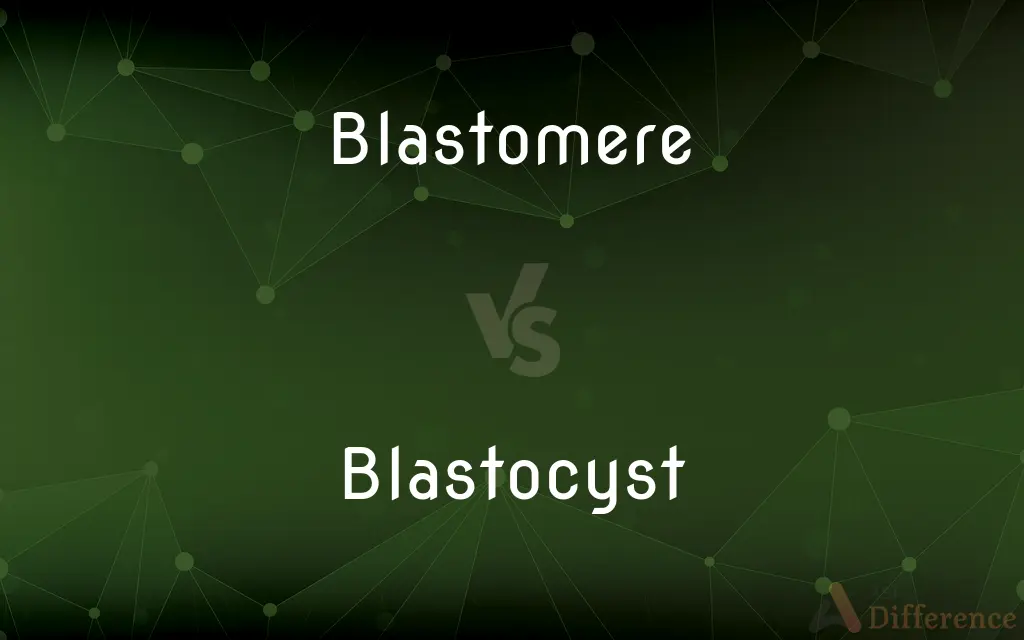Blastomere vs. Blastocyst — What's the Difference?
By Maham Liaqat & Fiza Rafique — Updated on March 27, 2024
Blastomeres are cells formed by the division of a fertilized egg, while a blastocyst is a structure formed in early development, consisting of an inner cell mass and an outer layer.

Difference Between Blastomere and Blastocyst
Table of Contents
ADVERTISEMENT
Key Differences
A blastomere is an individual cell resulting from the cleavage, or division, of the zygote after fertilization. These cells are totipotent in the earliest stages, meaning each can develop into a complete organism. On the other hand, a blastocyst is a later stage of development that occurs about five days after fertilization in humans, featuring differentiated cells that will form either the embryo or part of the placenta.
In the development process, blastomeres undergo several rounds of division without the embryo increasing in size, which leads to the formation of a morula. This eventually transitions into the blastocyst stage, where the structure becomes hollow, filling with fluid, and the cells start to specialize. Whereas blastomeres are essentially uniform in their early stages, blastocysts exhibit the first major differentiation of cells into specific types and structures.
The primary role of blastomeres is to contribute to the initial increase in cell number and to start the process of differentiation. In contrast, the blastocyst has the critical function of implantation into the uterine wall, a step that is vital for establishing a successful pregnancy. The blastocyst’s inner cell mass will develop into the embryo, while the outer layer, known as the trophoblast, will form the placenta and embryonic membranes.
Blastomeres are found in the earliest stages of embryonic development, making them crucial for the fundamental aspects of cell division and the embryo’s initial formation. Meanwhile, the blastocyst represents a more advanced developmental stage, crucial for pregnancy continuation and the establishment of key embryonic structures.
The study and manipulation of blastomeres are fundamental in research and assisted reproductive technologies, such as in vitro fertilization (IVF), where embryo quality is assessed at the blastocyst stage for a higher chance of successful implantation. This contrasts with the blastocyst, which is used in similar contexts but evaluated for different criteria, such as the development of the inner cell mass and the trophoblast, which are indicative of the potential for successful implantation and pregnancy.
ADVERTISEMENT
Comparison Chart
Definition
A cell formed by the division of a zygote.
A structure formed from blastomeres, consisting of an inner cell mass and an outer layer.
Stage of Development
Early cleavage stage (1-3 days post-fertilization).
Later stage (about 5 days post-fertilization).
Cellular Composition
Uniform, undifferentiated cells.
Differentiated cells forming inner cell mass and trophoblast.
Function
Contribute to cell number increase and initial differentiation.
Implantation into the uterine wall and establishment of embryonic structures.
Role in Reproduction
Essential for the early stages of embryogenesis.
Critical for the establishment of pregnancy and embryonic development.
Research and Clinical Use
Used in embryonic development studies and early stage reproductive technologies.
Assessed for implantation potential in IVF and related technologies.
Potential
Totipotent in the earliest stages.
Specialized cells with distinct functions and potential.
Importance in Development
Fundamental for the beginning of embryonic development.
Crucial for successful pregnancy continuation and development.
Compare with Definitions
Blastomere
Early embryonic cell resulting from zygote division.
A blastomere divides rapidly in the initial days post-fertilization.
Blastocyst
Differentiates into the embryo and placenta.
The inner cell mass of the blastocyst will become the embryo.
Blastomere
Totipotent cells capable of forming a complete organism.
Each blastomere has the potential to develop into a full organism.
Blastocyst
The stage assessed for implantation potential in IVF.
Embryologists select the healthiest blastocysts for transfer in IVF procedures.
Blastomere
Involved in the embryo's earliest developmental stages.
Blastomeres are critical for the embryo’s initial formation.
Blastocyst
A developmental structure featuring an inner cell mass and an outer layer.
The blastocyst stage is crucial for implantation into the uterine wall.
Blastomere
Undergoes cleavage without overall embryo size increase.
Despite the rapid division of blastomeres, the embryo does not enlarge initially.
Blastocyst
Forms about five days post-fertilization in humans.
The embryo develops into a blastocyst before implantation.
Blastomere
Forms the building blocks of the embryo.
Blastomeres aggregate to form the morula, preceding the blastocyst stage.
Blastocyst
Represents a key stage in pregnancy establishment.
Successful blastocyst implantation is a critical milestone in achieving pregnancy.
Blastomere
In biology, a blastomere is a type of cell produced by cleavage (cell division) of the zygote after fertilization and is an essential part of blastula formation.
Blastocyst
The blastocyst is a structure formed in the early development of mammals. It possesses an inner cell mass (ICM) which subsequently forms the embryo.
Blastomere
Any of the cells resulting from the cleavage of a fertilized ovum during early embryonic development.
Blastocyst
The modified blastula that is characteristic of placental mammals. Also called blastodermic vesicle.
Blastomere
(biology) Any cell that results from division of a fertilized egg.
Blastocyst
(biology) The mammalian blastula
Blastomere
One of the segments first formed by the division of the ovum.
Blastocyst
The germinal vesicle.
Blastomere
Any cell resulting from cleavage of a fertilized egg
Blastocyst
The blastula of mammals
Common Curiosities
Can a single blastomere develop into a full organism?
In the earliest stages of development, blastomeres are totipotent and have the potential to develop into a complete organism.
Are blastomeres present in a blastocyst?
Yes, a blastocyst is formed from blastomeres that have undergone differentiation.
What stage follows a blastomere in development?
The morula stage follows blastomere divisions, which then leads to the formation of a blastocyst.
What does the inner cell mass of a blastocyst become?
The inner cell mass of a blastocyst develops into the embryo.
What defines a blastocyst?
A blastocyst is a structure that forms about five days post-fertilization, consisting of differentiated cells that will become the embryo and placenta.
How are blastomeres used in research?
Blastomeres are studied in embryonic development research and used in early-stage reproductive technologies.
What is a blastomere?
A blastomere is an individual cell formed by the division of a zygote in early embryonic development.
How does a blastomere differ from a blastocyst in function?
Blastomeres are crucial for the early division and differentiation processes, while a blastocyst is essential for implantation and the establishment of key embryonic structures.
Why is the blastocyst stage important for IVF?
The blastocyst stage is critical in IVF because it has a higher chance of successful implantation when transferred to the uterus.
What role does the outer layer of a blastocyst play?
The outer layer, or trophoblast, of a blastocyst forms the placenta and embryonic membranes.
What differentiates a blastocyst from earlier stages?
A blastocyst is differentiated by its structure, consisting of an inner cell mass and an outer layer, and its function in implantation.
What is the clinical significance of the blastocyst stage?
The blastocyst stage is significant for assessing embryo quality and potential for successful implantation in clinical settings like IVF.
How is a blastocyst involved in pregnancy?
A blastocyst implants into the uterine wall, a crucial step in establishing and continuing a pregnancy.
What is the significance of blastomere division?
Blastomere division increases cell number and begins the differentiation process necessary for embryonic development.
What technologies rely on understanding blastomeres and blastocysts?
Assisted reproductive technologies like IVF rely on the manipulation and understanding of blastomeres and blastocysts.
Share Your Discovery

Previous Comparison
Jumper vs. Dumper
Next Comparison
Clothing vs. ClothesAuthor Spotlight
Written by
Maham LiaqatCo-written by
Fiza RafiqueFiza Rafique is a skilled content writer at AskDifference.com, where she meticulously refines and enhances written pieces. Drawing from her vast editorial expertise, Fiza ensures clarity, accuracy, and precision in every article. Passionate about language, she continually seeks to elevate the quality of content for readers worldwide.
















































